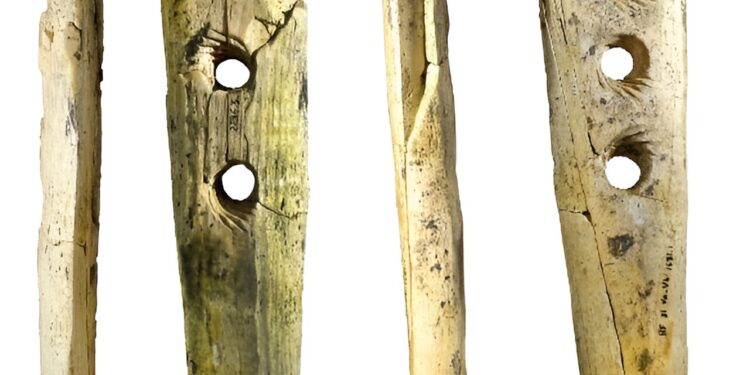Ivory perforated staff from the Hohle Fels cave, southwest Germany, with four views. Credit: Scientists progress (2024). DOI: 10.1126/sciadv.adh5217
Two historians from the University of Tübingen have found evidence that an ancient staff, believed to be a work of art created by early humans thousands of years ago, is actually a device to help make some ropes. In their study, published in the journal Scientists progressNicholas Conard and Veerle Rots created a replica of the staff and discovered that it could easily be used to make rope.
In 2015, several pieces of ivory were discovered in a cave in Hohle Fels in Germany, all of which showed signs of being made. Dating of the pieces showed that they were made around 37,000 years ago, probably by modern man. Since then, researchers have believed that the ivory pieces were fashioned from a mammoth tusk as works of art. In this new study, researchers found evidence that at least one of them was instead a stick carved in a way that made rope making easier.
Previous research has shown that early humans made ropes thousands of years ago and lived in the region of Germany where the batons were found. One of the pieces, a stick about 21 cm long, looked to the researchers like a modern cricket bat with four holes cut into its flattest part.
Working on a hunch, the researchers studied the stick and found signs of wear on the edges of the holes, as well as grooves, indicating that something had been repeatedly pulled through them. The residue on the walls of the hole suggested it was some sort of plant matter.
Macro and microscopic images of the perforated ivory stick and traces of residue. Credit: Scientists progress (2024). DOI: 10.1126/sciadv.adh5217
Convinced that the stick had been used to make rope, the researchers created a replica of the stick and then tried to use it in that way. They experimented with several materials, including nettle, willow, basswood, cattail, hemp, flax and deer sinew. They found that the stick would have worked well for such a purpose.
Making a rope involves braiding, like braiding hair, using multiple strands. To make rope using the stick, individual strands were passed through the holes, which held them in place. As the strands were passed together, a person on the opposite side would wind them together, resulting in a well-formed rope.
More information:
Nicholas J. Conard et al, Rope making in the Aurignacian of Central Europe over 35,000 years ago, Scientists progress (2024). DOI: 10.1126/sciadv.adh5217
© 2024 Science X Network
Quote: Experiments suggest an ancient four-hole ivory stick was used to make rope (February 1, 2024) retrieved February 1, 2024 from
This document is subject to copyright. Except for fair use for private study or research purposes, no part may be reproduced without written permission. The content is provided for information only.



